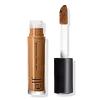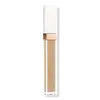e.l.f. cosmetics 16hr Camo Concealer Versus Flower Beauty by Drew Light Illusion Full Coverage Concealer
What's inside
What's inside
 Key Ingredients
Key Ingredients

 Benefits
Benefits

 Concerns
Concerns

 Ingredients Side-by-side
Ingredients Side-by-side

Water
Skin ConditioningCyclopentasiloxane
EmollientAcrylates Crosspolymer
AbsorbentButylene Glycol
HumectantPEG-10 Dimethicone
Skin ConditioningTrimethylsiloxysilicate
EmollientCetyl PEG/PPG-10/1 Dimethicone
EmulsifyingSodium Chloride
MaskingPersea Gratissima Oil
Skin ConditioningKaolin
AbrasiveSilica
AbrasiveDimethicone
EmollientDimethicone/Vinyl Dimethicone Crosspolymer
Skin ConditioningDisteardimonium Hectorite
StabilisingAcrylates/Dimethicone Copolymer
Skin ConditioningPolyhydroxystearic Acid
EmulsifyingTriethoxycaprylylsilane
Caprylyl Glycol
EmollientDisodium EDTA
Ethylhexylglycerin
Skin ConditioningPhenoxyethanol
PreservativeCI 77891
Cosmetic ColorantIron Oxides
Water, Cyclopentasiloxane, Acrylates Crosspolymer, Butylene Glycol, PEG-10 Dimethicone, Trimethylsiloxysilicate, Cetyl PEG/PPG-10/1 Dimethicone, Sodium Chloride, Persea Gratissima Oil, Kaolin, Silica, Dimethicone, Dimethicone/Vinyl Dimethicone Crosspolymer, Disteardimonium Hectorite, Acrylates/Dimethicone Copolymer, Polyhydroxystearic Acid, Triethoxycaprylylsilane, Caprylyl Glycol, Disodium EDTA, Ethylhexylglycerin, Phenoxyethanol, CI 77891, Iron Oxides
Water
Skin ConditioningDimethicone
EmollientTrimethylsiloxysilicate
EmollientCaprylyl Methicone
Skin ConditioningIsoamyl Laurate
EmollientIsododecane
EmollientButylene Glycol
HumectantGlycerin
HumectantMica
Cosmetic ColorantEthylhexyl Palmitate
EmollientHdi/Trimethylol Hexyllactone Crosspolymer
Silica
AbrasivePEG/PPG-18/18 Dimethicone
EmulsifyingPEG-10 Dimethicone
Skin ConditioningHydrogenated Lecithin
EmulsifyingC10-18 Triglycerides
EmollientSodium Chloride
MaskingQuaternium-90 Bentonite
Aroma
Jojoba Esters
EmollientCaprylyl Glycol
EmollientHelianthus Annuus Seed Wax
Skin ConditioningPhenoxyethanol
PreservativeDimethicone/Vinyl Dimethicone Crosspolymer
Skin ConditioningPotassium Sorbate
PreservativeSodium Dehydroacetate
PreservativePropylene Carbonate
SolventSodium Gluconate
Skin ConditioningHexylene Glycol
EmulsifyingAcacia Decurrens Flower Wax
EmollientPolyglycerin-3
HumectantQuartz
AbrasiveTitanium Dioxide
Cosmetic ColorantIron Oxides
Water, Dimethicone, Trimethylsiloxysilicate, Caprylyl Methicone, Isoamyl Laurate, Isododecane, Butylene Glycol, Glycerin, Mica, Ethylhexyl Palmitate, Hdi/Trimethylol Hexyllactone Crosspolymer, Silica, PEG/PPG-18/18 Dimethicone, PEG-10 Dimethicone, Hydrogenated Lecithin, C10-18 Triglycerides, Sodium Chloride, Quaternium-90 Bentonite, Aroma, Jojoba Esters, Caprylyl Glycol, Helianthus Annuus Seed Wax, Phenoxyethanol, Dimethicone/Vinyl Dimethicone Crosspolymer, Potassium Sorbate, Sodium Dehydroacetate, Propylene Carbonate, Sodium Gluconate, Hexylene Glycol, Acacia Decurrens Flower Wax, Polyglycerin-3, Quartz, Titanium Dioxide, Iron Oxides
 Reviews
Reviews

Ingredients Explained
These ingredients are found in both products.
Ingredients higher up in an ingredient list are typically present in a larger amount.
Butylene Glycol (or BG) is used within cosmetic products for a few different reasons:
Overall, Butylene Glycol is a safe and well-rounded ingredient that works well with other ingredients.
Though this ingredient works well with most skin types, some people with sensitive skin may experience a reaction such as allergic rashes, closed comedones, or itchiness.
Learn more about Butylene GlycolCaprylyl Glycol is a humectant and emollient, meaning it attracts and preserves moisture.
It is a common ingredient in many products, especially those designed to hydrate skin. The primary benefits are retaining moisture, skin softening, and promoting a healthy skin barrier.
Though Caprylyl Glycol is an alcohol derived from fatty acids, it is not the kind that can dry out skin.
This ingredient is also used as a preservative to extend the life of products. It has slight antimicrobial properties.
Learn more about Caprylyl GlycolDimethicone is a type of synthetic silicone created from natural materials such as quartz.
What it does:
Dimethicone comes in different viscosities:
Depending on the viscosity, dimethicone has different properties.
Ingredients lists don't always show which type is used, so we recommend reaching out to the brand if you have questions about the viscosity.
This ingredient is unlikely to cause irritation because it does not get absorbed into skin. However, people with silicone allergies should be careful about using this ingredient.
Note: Dimethicone may contribute to pilling. This is because it is not oil or water soluble, so pilling may occur when layered with products. When mixed with heavy oils in a formula, the outcome is also quite greasy.
Learn more about DimethiconeThis ingredient is a silicone used to improve the texture of products and absorb oil. It does not get absorbed into the skin.
Like other silicones, Dimethicone/Vinyl Dimethicone Crosspolymer helps condition the skin by creating a barrier. In this sense, it can act as an emollient and trap moisture in.
This ingredient is a type of elastomer.
Learn more about Dimethicone/Vinyl Dimethicone CrosspolymerPeg-10 Dimethicone is silicone with conditioner and emulsifier properties. It mostly acts as an emollient in skincare and and humectant in haircare.
According to the manufacturer, acidic formulations decrease the stability of this ingredient. It works best in neutral or near neutral formulations.
Phenoxyethanol is a preservative that has germicide, antimicrobial, and aromatic properties. Studies show that phenoxyethanol can prevent microbial growth. By itself, it has a scent that is similar to that of a rose.
It's often used in formulations along with Caprylyl Glycol to preserve the shelf life of products.
Silica, also known as silicon dioxide, is a naturally occurring mineral. It is used as a fine, spherical, and porous powder in cosmetics.
Though it has exfoliant properties, the function of silica varies depending on the product.
The unique structure of silica enhances the spreadability and adds smoothness, making it a great texture enhancer.
It is also used as an active carrier, emulsifier, and mattifier due to its ability to absorb excess oil.
In some products, tiny microneedles called spicules are made from silica or hydrolyzed sponge. When you rub them in, they lightly polish away dead skin layers and enhance the penetration of active ingredients.
Learn more about SilicaChances are, you eat sodium chloride every day. Sodium Chloride is also known as table salt.
This ingredient has many purposes in skincare: thickener, emulsifier, and exfoliator.
You'll most likely find this ingredient in cleansers where it is used to create a gel-like texture. As an emulsifier, it also prevents ingredients from separating.
There is much debate on whether this ingredient is comedogenic. The short answer - comedogenic ratings don't tell the whole story. Learn more about comegodenic ratings here.
The concensus about this ingredient causing acne seems to be divided. Research is needed to understand if this ingredient does cause acne.
Scrubs may use salt as the primary exfoliating ingredient.
Learn more about Sodium ChlorideThis silicone is an emollient. Emollients create a thin film on the skin to prevent moisture from escaping.
It is not soluble in water and helps increase water-resistance in products.
According to a manufacturer, it can blend seamlessly with silicone oils, such as Cyclopentasiloxane.
Learn more about TrimethylsiloxysilicateWater. It's the most common cosmetic ingredient of all. You'll usually see it at the top of ingredient lists, meaning that it makes up the largest part of the product.
So why is it so popular? Water most often acts as a solvent - this means that it helps dissolve other ingredients into the formulation.
You'll also recognize water as that liquid we all need to stay alive. If you see this, drink a glass of water. Stay hydrated!
Learn more about WaterThis ingredient is a combination of red, black, and yellow iron oxide pigments. This combination of colors is usually found in foundation, because it results in a "skin" color.